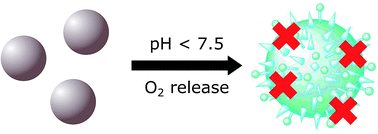Biofunctionalized zinc peroxide (ZnO2) nanoparticles as active oxygen sources and antibacterial agents†
Abstract
Oxygen is one of the most important substances for physiological reactions and metabolisms in biological systems. Through the tailored design of oxygen-releasing materials it might be possible to control different biological processes. In this work we synthesized for the first time zinc peroxide nanoparticles with controlled sizes and biofunctionalized surfaces using a one-step reaction procedure. The zinc peroxide nanoparticles were obtained with tunable sizes (between 4.0 ± 1.2 nm and 9.4 ± 5.2 nm) and were decorated with glucose 1-phosphate (Glc-1P). The specific interaction of the phosphate function of Glc-1P with the nanoparticle surface was monitored by solid state 31P-NMR and zeta-potential measurements. Furthermore, using fluorescence measurements we demonstrated that anchored glucose molecules on the nanoparticle surface are accessible for specific interactions with lectins. It could be shown that these interactions strongly depend on the amount of Glc-1P attached to the nanoparticle surface. Additionally it was demonstrated that the oxygen release from biofunctionalized zinc peroxide nanoparticles could be tuned according to the chemical composition of the nanoparticles and the pH of the aqueous solution. The antibacterial efficiency of the synthesized nanoparticles against Enterococcus faecalis, Aggregatibacter actinomycetemcomitans, Porphyromonas gingivalis and Prevotella intermedia was evaluated by determination of minimal bactericidal concentration (MIC).



 Please wait while we load your content...
Please wait while we load your content...